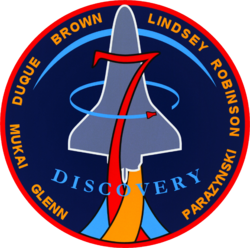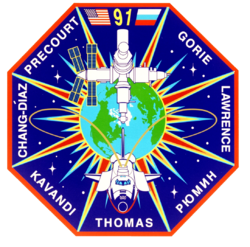STS-95
| STS-95 | |||||
 | |||||
| Uppdrag | 92[1] | ||||
|---|---|---|---|---|---|
| Rymdfärja | Discovery (25)[1] | ||||
| NSSDC-ID | 1998-064A[2] | ||||
| Färdens tid | 8 dagar, 21 timmar, 44 minuter, 56 sekunder | ||||
| Uppskjutning | |||||
| Startplats | Startplatta 39B vid Kennedy Space Center i Florida | ||||
| Start | 29 oktober 1998 2:20:19 p.m. EST | ||||
| Landning | |||||
| Landningsplats | KSC, Runway 33. | ||||
| Landning | 7 november 1998 12:04pm EST | ||||
| Omloppsbana | |||||
| Varv | 134 st[3] | ||||
| Apogeum | 561 km | ||||
| Perigeum | 550 km | ||||
| Banlutning | 28,45° | ||||
| Sträcka | 5,8 miljoner km | ||||
| Besättning | |||||
| Befälhavare | Curtis L. Brown (5) | ||||
| Pilot | Steven W. Lindsey (2) | ||||
| Uppdragsspecialister | Scott E. Parazynski (3) Pedro Duque (1) (ESA) | ||||
| Nyttolastspecialister | Stephen K. Robinson (2) Chiaki Mukai (2) (NASDA) John H. Glenn (2) | ||||
 | |||||
| Kronologi Rymdfärjeprogrammet | |||||
| |||||
STS-95 var en flygning i det amerikanska rymdfärjeprogrammet med rymdfärjan Discovery. Den sköts upp från Pad 39B vid Kennedy Space Center i Florida den 29 oktober 1998. Efter nästan nio dagar i omloppsbana runt jorden återinträdde rymdfärjan i jordens atmosfär och landade vid Kennedy Space Center.
Genom flygningen blev amerikanen John H. Glenn den äldsta personen i rymden, då han var 77 år vid flygningen.
Väckningar
Under Geminiprogrammet började NASA spela musik för besättningar och sedan Apollo 15 har man varje "morgon" väckt besättningen med ett musikstycke, särskilt utvalt antingen för en enskild astronaut eller för de förhållanden som råder.
| Dag | Låt | Artist/Kompositör | Spelad för | Länk |
|---|---|---|---|---|
| 2 | "What a Wonderful World" | Louis Armstrong | Scott Parazynski. | WAV |
| 3 | "Cachito" | Nat King Cole | Pedro Duque | WAV |
| 4 | "This Pretty Planet" och "Halelujahs" | Tom Chapin och Chris Rice | Steven Lindsey | WAV |
| 5 | "Moon River" | Andy Williams | John Glenn | WAV |
| 6 | "The House is Rockin'" | Stevie Ray Vaughan | Steve Robinson | WAV |
| 7 | "Wakaki Chi" (Young Spirit) | (Keio University) | Chiaki Mukai | WAV |
| 8 | "I Know You're Out There Somewhere" | The Moody Blues | Curtis Brown | |
| 9 | "Voyage Into Space" | Peter Nero | John Glenn | WAV |
| 10 | "La Cucaracha" | Pedro Duque | WAV |
Se även
Referenser
- ^ [a b] NASA Space Shuttle Launch Archive, läst 28 juli 2016.
- ^ ”NASA Space Science Data Coordinated Archive” (på engelska). NASA. https://nssdc.gsfc.nasa.gov/nmc/spacecraft/display.action?id=1998-064A. Läst 22 mars 2020.
- ^ Manned Astronautics - Figures & Facts Arkiverad 4 mars 2016 hämtat från the Wayback Machine., läst 28 juli 2016.
Externa länkar
 Wikimedia Commons har media som rör STS-95.
Wikimedia Commons har media som rör STS-95.
| ||||||||
| ||||||||||||||||||||||||||||||||
Media som används på denna webbplats
Författare/Upphovsman: Pascal (Flickr user: pasukaru76), Licens: CC0
Vostok spacecraft replica at the Technik Museum Speyer, Germany.
The STS-95 patch, designed by the crew, is intended to reflect the scientific, engineering, and historic elements of the mission. The Space Shuttle Discovery is shown rising over the sunlit Earth limb, representing the global benefits of the mission science and the solar science objectives of the Spartan Satellite. The bold number '7' signifies the seven members of Discovery's crew and also represents a historical link to the original seven Mercury astronauts. The STS-95 crew member John Glenn's first orbital flight is represnted by the Friendship 7 capsule. The rocket plumes symbolize the three major fields of science represented by the mission payloads: microgravity material science, medical research for humans on Earth and in space, and astronomy.
Designed by the crew members, this patch commemorates the first assembly flight to carry United States-built hardware for constructing the International Space Station (ISS). This flight's primary task is to assemble the cornerstone of the Space Station: the Node with the Functional Cargo Block (fgb). The rising sun symbolizes the dawning of a new era of international cooperation in space and the beginning of a new program: the International Space Station. The Earth scene outlines the countries of the Station Partners: the United States, Russia, those of the European Space Agency (ESA), Japan, and Canada. Along with the Pressurized Mating Adapters (PMA) and the Functional Cargo Block, the Node is shown in the final mated configuration while berthed to the Space Shuttle during the STS-88/2A mission. The Big Dipper Constellation points the way to the North Star, a guiding light for pioneers and explorers for generations. In the words of the crew, "These stars symbolize the efforts of everyone, including all the countries involved in the design and construction of the International Space Station, guiding us into the future."
Five astronauts based at the Johnson Space Center (JSC) and two payload specialists take a break from their training schedule to pose for the STS-95 pre-flight portrait. Seated are astronauts Curtis L. Brown Jr. (right), mission commander; and Steven W. Lindsey, pilot. Standing, from the left, are Scott F. Parazynski and Stephen K. Robinson, both mission specialists; Chiaki Mukai, payload specialist representing Japan's National Space Development Agency (NASDA); Pedro Duque, mission specialist representing the European Space Agency (ESA); and U.S. Sen. John H. Glenn Jr., payload specialist. The seven are scheduled to be launched into Earth orbit aboard the Space Shuttle Discovery in late October of this year.
STS-91 CREW INSIGNIA (March 1998) --- This is the crew patch for the STS-91 mission -- the ninth flight of the Shuttle-Mir Phase One docking missions. The crew will bring back Andrew S. W. Thomas, the last long-duration American crew member flown on the Russian Space Station Mir. This mission marks the end of the Shuttle-Mir Phase One Program and will open the way for Phase Two: construction of the International Space Station (ISS). The crew patch depicts the rendezvous of the Space Shuttle Discovery with the Space Station Mir. The flags of the United States and Russia are displayed at the top of the patch and both countries are visible on the Earth behind the two spacecraft. The names of the American crew members surround the insignia on the outer areas, with the name of cosmonaut Valery Ryumin in Cyrillic at the lower right. The Alpha Magnetic Spectrometer (AMS) is an international payload planned to fly in the payload bay of Discovery. Two thin golden streams flowing into the AMS represent charged elementary particles. The detection of antimatter in space will help scientists better understand the physics and origins of the universe.






